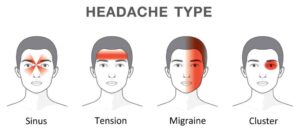Headaches and Chiropractic Care
Do you suffer from headaches? You’re not alone, 9 out of 10 Americans suffer from headaches. Headaches can ruin your day, leave you bed-ridden, and are hard to get rid of. They are also complex with varying triggers. Sometimes it’s as simple as weather change that can trigger a headache, others can be due to stress or a change in diet. What do you do when you get a headache? Instead of powering through a headache or possibly taking a pill to subdue the pain, there is a better alternative method that will help relieve the pain. Research shows regular spinal adjustments may be an effective form of treatment for headaches.
Types of headaches
A tension headache is the most common type of headache. A tension headache is generally a diffuse, mild to moderate pain in the head, scalp, or neck, that’s often associated with muscle tightness in these areas and described as feeling like a tight band around your head.
Cluster
Cluster headaches occur when a nerve pathway in the base of your brain is triggered. That signal seems to come from a deeper part of the brain called the hypothalamus, home of the “internal biological clock” that controls your sleep and wake cycles. The nerve that’s affected, the trigeminal nerve, is responsible for sensations such as heat or pain in your face. It’s near your eye, and it branches up to your forehead, across your cheek, down your jaw, and above your ear on the same side.
Migraines
A migraine can cause severe throbbing pain or a pulsing sensation, usually on one side of the head. It’s often accompanied by nausea, vomiting, and extreme sensitivity to light and sound. Migraine attacks can last for hours to days, and the pain can be so severe that it interferes with your daily activities.
Sinus
Your sinuses are air-filled spaces inside your forehead, cheekbones, and behind the bridge of your nose. When they get inflamed, they swell, make more mucus, and the channels that drain them can get blocked. The build-up of pressure in your sinuses causes pain that feels like a headache.
Triggers
There is a lot of things that can cause a headache or a migraine. These include, but are not limited to:
- Subluxations: Added pressure on the nerves of our spine can result in headaches.
- Diet: Different foods such as nitrates and sulfates can trigger headaches or migraines. Other foods include nuts, dairy products, bananas, citrus, and beans.
- Stress: Stress can cause muscles in our neck and upper back to tighten up which can cause tension headaches.
- Alcohol: One of the main ingredients in alcohol is ethanol. Ethanol has been known to cause headaches and migraines, as well has the fact that it is a diuretic which dehydrates you. Alcohol dehydrates your body making your blood thicker (more viscous), which puts more stress on your blood vessels which is why you may feel like your head is throbbing after a night of drinking.
- Environmental: A quick change in weather or barometric pressure can trigger a headache. As well as, certain scents, loud sounds, and bright lights can cause your stimuli to be overactive which may lead to a headache.
- Hormones: Changing levels of estrogen can play a role in headaches and migraines. Due to this, women are more likely to get headaches and migraines than men.
- Caffeine: Too much caffeine can lead to dehydration which leads to a headache. On the inverse, if you get to little caffeine when you’re used to a lot of it can cause a headache as well.
- Lack of sleep: Too little sleep, as well as oversleeping can lead to headaches.
Chiropractic care and prevention of headaches
What you can do
As Americans, our lifestyles have become increasingly sedentary. If you find yourself sitting at your desks or your couch for several hours, make sure to take regular breaks every 30-60 minutes to stretch and walk around. This will not only increase your productivity at work, but your back will thank you as well. It’s also important to regularly stretch and exercise to create strong and flexible muscles to support your skeletal system.
What the Chiropractor does
Chiropractors correct subluxations (the misalignment of the vertebrae that puts pressure on the Nervous System) in the spine. Through regularly adjusting the neck, pressure is released and can help relieve any stress that is put on the back and neck. This allows your body to function more normally and reduces risk of stress and tension building until headache pain develops.
Chiropractors also help provide patients with stretches and exercises that help target specific problem areas. They also offer advice on diet and nutrition, posture, ergonomics (work postures), and relaxation techniques. This advice should help to relieve the recurring joint irritation and tension in the muscles of the neck and upper back. So, before you turn to your medication to get rid of your headache, visit your chiropractor to see how you can resolve your pain naturally.


